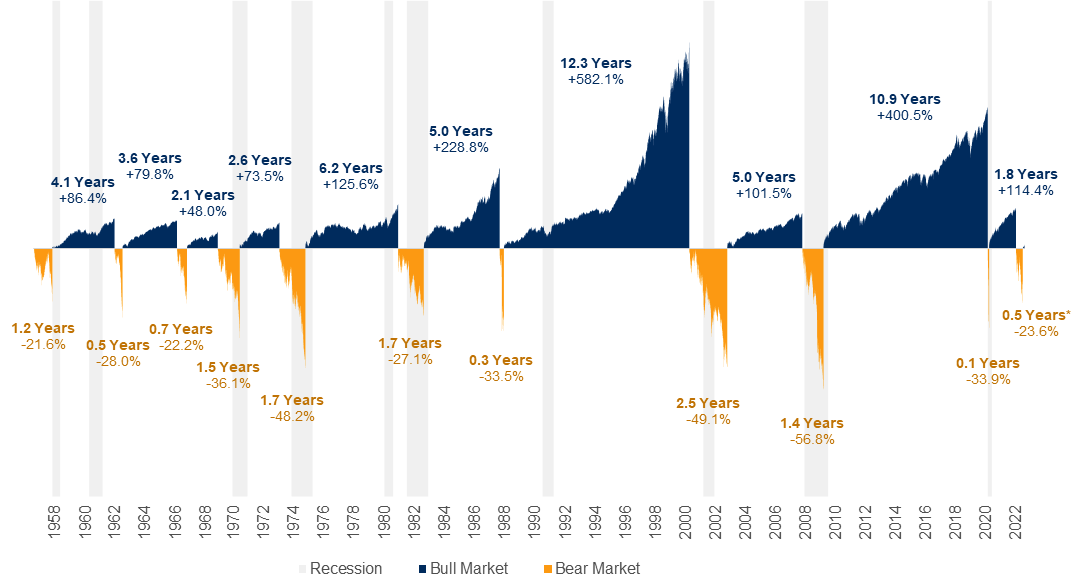As an investor, it’s natural to feel uncertain from time to time. This is especially true when markets are reacting sharply to changing economic conditions. We’ve certainly experienced this during the COVID-19 pandemic, as it continues to impact global economies, financial markets and our daily lives in unprecedented ways. During this period of crisis, it can be helpful to reflect on the past as a means to help frame the eventual path forward.
Setting the stage
In the world of investing, the terms bear market and bull market are frequently cited. However, there is some debate over the precise definition of each term.
- Bear market: occurs when an index or asset drops 20% or more, encompassing the period of time from market peak to market trough.
- Bull market: can be thought of as all periods between the bears, from market trough to market peak.
Using these definitions, U.S. equities officially earned their bear market label on March 12th, when the S&P 500 closed down over 20% from the all-time high it set just 22 days before. This decline marked the end of the bull market which began at the depths of the global financial crisis on March 9, 2009.
We’ve been here before
Despite the uneasy feelings associated with any pullback in financial markets, it can be reassuring to know that these are not uncharted waters. In fact, if you look at U.S. equity markets spanning the past 70 years, there were10 distinct bear market events. This suggests that on average, long-term investors should expect to encounter a bear market roughly once every 7 years.
A history of U.S equity of bull & bear markets

As of June 13, 2022. Reflects S&P 500 Index. Source: RBC GAM, Bloomberg. An investment cannot be made directly into an index. The graph does not reflect transaction costs, investment management fees or taxes. If such costs and fees were reflected, returns would be lower. Past performance is not a guarantee of future results. Bull market starts from lowest close reached after market has fallen 20% or more. Bear market starts from when the index closes at least 20% down from its previous high.
- Bear markets come in all shapes and sizes. Some bear markets are mild and quick, like the one in 1957 where U.S. equities fell 20.7% and then began to recover in about 3 months. Other bears have been quite severe. For instance, during the global financial crisis, U.S. equities fell nearly 57% during a bear market that lasted roughly a year and a half.
- Long-term resiliency of markets. Regardless of the severity or length of the pullback, markets have always recovered along the path to achieving new highs.
- Lower asset prices should lead to higher long-term returns. Trying to time the bottom of a bear market is next to impossible. That said, regardless of when people invest during a bear market, history suggests they usually see positive subsequent returns over the long term.
The chart below shows that each time the market has dropped by a significant amount, the bounce back in the following year has also been significant. This pattern has repeated across bear markets since 1950.

Source: RBC GAM, Bloomberg. S&P 500 TR (USD). Data reflects time period of January 1, 1950 to February 29, 2020. Subsequent 1-year return reflects the median 1-year return. An investment cannot be made directly into an index. The graph does not reflect transaction costs, investment management fees or taxes. If such costs and fees were reflected, returns would be lower. Past performance is not a guarantee of future results.
Watching the value of your investments fluctuate can be an emotional experience. Yet, while it may not feel like it in the moment, bear markets are a normal part of the long-term investment cycle. During these times, making dramatic changes to your investment portfolio may feel like a natural reaction. However, this can have a serious impact on your ability to reach your long-term goals.
It’s not easy to balance what you read in the headline risks with your knowledge of the improved long-term return potential. However, doing so in the context of a carefully considered financial plan greatly improves the odds of investment success. In fact, it may even help you view periods of market weakness as an opportunity to buy investments on sale.
It's important to stick to your financial plan - and that means managing portfolio drift when markets move. Your advisor can help.
